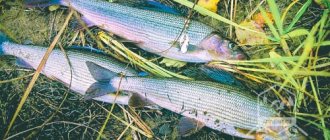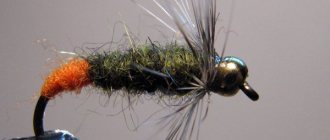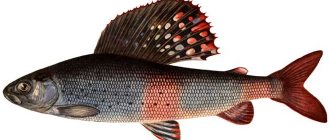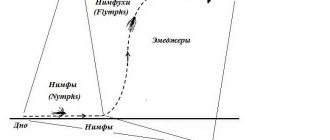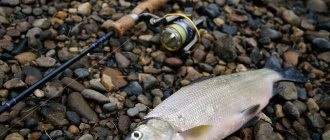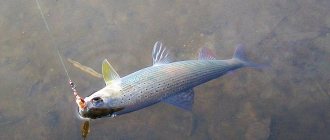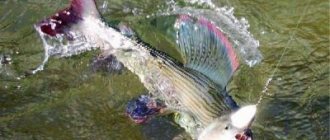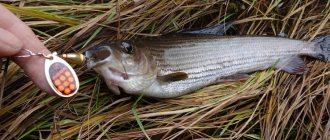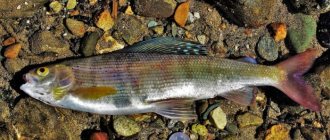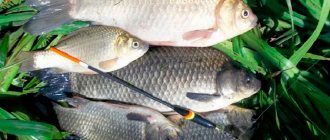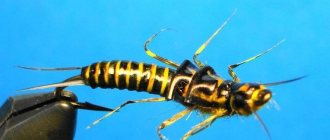Grayling is a small fish of the salmon family. A distinctive feature is the huge fin on the back. Grayling is one of the many favorite fish of float and fly fishermen. Fish meat contains little protein and fat, so it is considered dietary and has an excellent taste.
Grayling has an elongated and strong body, which helps it move quickly under water. The body is covered with tightly fitting and large scales. The scales have a multi-colored shiny color that gives off a greenish and sometimes even bluish tint.
Grayling loves cool, clean and fast water saturated with oxygen; it lives most often in mountain rivers and less often in plains. It is very rare to find it in ordinary lakes. It can also live in brackish water. He loves winding mountain rivers, where there are many holes and rapids, the bottom surface is stone or pebbles. Graylings live in deep holes only in winter; there is no point in looking for them there in summer. There should be a clean area of water near the parking area where it looks for prey.
Graylings feed in the morning and evening, when the sun's light is not so bright. Around this time, the fish swims at the surface of the water to search for insects. During the day, Grayling can be on the bottom in secluded places, under stones and near large snags.
Grayling flies are bait that imitates small insects, which are a favorite delicacy of fish and most inhabitants of fresh water bodies. You can expect the best results from fishing with this bait in late spring and early summer. When the fish experiences the so-called “Zhor”, at this time it bites on almost any food offered.
Types of flies for grayling
As with any other bait, there can be a huge variety of flies.
Types of flies for grayling:
- Heavy fly (wet).
This species is similar to small larvae that fall into a pond as winged insects. The structural features of the fly are a thin, elongated body with a tail, and there are also wings directed towards the sting. It is recommended to use a heavy fly when fly fishing. Fish such as grayling, asp, and salmon will not refuse such bait. - Dry flies.
These flies are considered universal among fishermen. This bait imitates invertebrate insects: a fly or a dragonfly. Such “insects” are made from bird feathers, which causes the bait to remain on the surface of the reservoir. - Streamers.
A very original and effective bait. The fly simulates the behavior of a wounded fish, which does not leave many predators unnoticed. The fly looks oblong, often the length of the body exceeds the length of the hook. They also try to make fins and a head in order to accurately recreate the silhouette of a small fish. For streamers, heavy weights made of tungsten steel are used. - Nymphs.
Such baits are similar to small pupae or larvae, that is, insects at the formation stage. You should select this fly based on the nature of the reservoir where you are going to fish, since this bait is very picky in this regard. - Emerger.
The bait is perfect for catching grayling. Such flies are similar to the transition of a larva into an adult, which is an excellent treat even for the most well-fed predator. - Fantasy flies.
Samples that do not have real prototypes. Most often they are made at the discretion of the fisherman. It is impossible to say exactly which fish baits will be more effective on; what matters is the place where you usually fish and the taste preferences of the desired prey.
Promising fishing spots
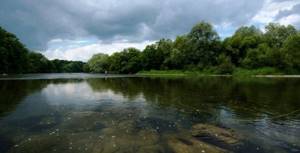
So, let us immediately note that during the autumn period grayling does not stay in one place for a long time. It constantly migrates across the pond in search of food. If the routes along which migration occurs are known, then you can already count on catching several trophies. If such information is not available, then you will need to spend a little time searching for active fish. First of all, pay attention to these places:
- areas where the channel narrows, exits from the pool or reach;
- riffles;
- mouths of small rivers and streams;
- deep areas with whirlpools;
- places where small rivers and streams flow into the main channel.
Recommended reading: How to catch tench with a fishing rod
Tackle for fishing grayling with flies
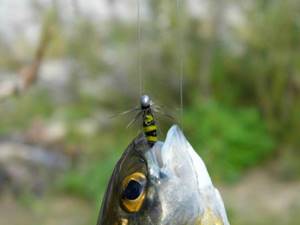
This fish is a desirable catch for any fisherman. Therefore, it is not surprising that such effective tackle as a fly is used to catch grayling. Catching fish with this bait leaves the opportunity to choose gear for almost any conditions or preferences of the fisherman.
Fly fishing
Sufficiently effective and simple gear. In most cases, it is recommended for beginners. The gear consists of: a rod, a fly, a reel and a cord.
For successful fishing, all you have to do is learn how to cast correctly and you can go hunting for grayling.
Spinning
The equipment used for spinning for grayling is unusual. For successful fishing you will need an inertia-free reel and a bombard for longer and more accurate casts. The use of a leash is also mandatory. A fishing line from 0.2 mm is suitable for it
Tackle "boat"
The boat tackle is one of the oldest ways of catching grayling. This type of tackle consists of non-sinking material (foam is most suitable), a rigid spinning rod and leashes of different diameters. The principle of such fishing is simple: a floating structure is floated downstream, leashes of different lengths are tied to the main fishing line, and the fly itself is attached to them. This method of fishing is very old and fascinating. It was used to catch trophy fish, and, as a rule, large fish are quite careful.
"Pull"
“Peretyag” is another ancient, but at the same time working method of catching grayling and other types of fish that feed at the surface of the reservoir. For this gear you will need two fishermen on different banks. Here, as in the case of the boat, leashes with flies are attached to the main fishing line, but instead of the boat, a second angler will serve. He will fish out the caught trophy, and another person will play off the fishing line. This is the fishing method our great-grandfathers used.
How to tie a fly on grayling
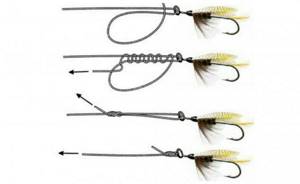
There are many ways to tie a fly for grayling to the main fishing line, the only thing is which one the angler himself knows best. One of the most common units for installation is the “Clinch”. It is often used to tie ordinary hooks.
In order to tie a fly using a Clinch knot, you need to do the following steps:
- we take the bait in our hand, so that the eye of the hook is in the finger and the sting is looking down;
- we thread the main line from top to bottom and cross it as with a normal knot;
- then with the formed end we make 5-6 turns around the main line;
- thread the end into the loop formed and tighten.
Thus, we get a strong and reliable connection. If during installation a part of the bait moves, you should move it away and then return it to its place; the quality of fishing will not change.
Advantages and disadvantages, types of artificial bait
Fishermen were forced to start producing artificial insects by problems associated with the extraction and storage of natural baits. How long does it take to dig up worms or catch insects? But how to bring them alive if the path to the “black stones” is covered in several hours.
Having taken a closer look at the insects that fish love, craftsmen began tying artificial flies. It turned out that using available materials, it is possible to successfully imitate insects and their larvae. And this is the main food of grayling. The advantages of flies include:
- versatility;
- minimum weight and dimensions;
- reliable installation on the fishing line;
- long service life;
- low costs for self-production.
As for the negative aspects, many anglers categorically do not want to engage in tying flies for grayling. There is simply not enough patience, skill in handling thread and creativity. It’s a shame to lose catchy models when bitten by a toothy predator or with a dead hook.
All baits are usually divided into two groups.
- Dry flies are designed to imitate the behavior of insects that have fallen into water. Outwardly, they resemble wasps, moths, dragonflies, flies, etc. A distinctive feature of this group is the presence of fluffy plumage. For knitting dry patterns, materials such as bird feathers, fur of domestic and wild animals are used. Hooks are selected to the minimum size from thin wire.
Photo 1. Dry flies.
Photo 2. Wet flies.
How to catch grayling with a fly

Catching grayling with a fly is not an easy task, but at the same time very exciting. A fisherman should carefully approach the choice of gear and fishing technique, and it is also very important to have a sufficient arsenal of bait with him. Therefore, as with any predator, you should experiment with flies. As you go through the different options, you will definitely come across the one that the fish prefers the most.
The most suitable time for fishing for grayling is warm spring, when the fish begins to actively feed at the surface of the reservoir. It is important not to miss this moment, since in the summer there will be enough insects near the water, which will reduce the demand for a fly for catching grayling. Also, starting from the end of August and up to October, the fish will actively peck at the bait in the form of an insect.
Choosing a fly depending on the season
When choosing a fly for catching grayling, take into account the following seasonal patterns:
- In early spring, in the upper reaches of large rivers, this fish is caught using large sinking flies. This is due to the fact that the water at this time is cloudy and cold.
- In early to mid-May, when the flood turbidity gradually subsides and the water warms up to a temperature of 11-12 C, grayling are more actively caught using dry floating flies.
- In summer, the choice of bait depends on the fishing conditions. In warm, non-rainy weather, both sinking wet flies and surface dry flies work well. After heavy rainfalls, when the water in the river becomes cloudy, sinking wet baits work better.
- In autumn and spring, grayling are more active in taking heavy and bulky sinking baits.
When choosing bait, in addition to the season, the species composition of insects in a particular area is also taken into account. The flies are selected to most realistically imitate the living creatures that the fish feed on.
On a note! Flies are used not only for catching grayling in the summer or in the off-season. Knowing the usual fishing spots, you can successfully catch grayling from under the ice using lure bait in winter.
The most catchy flies for grayling
For more successful fishing, this list presents the most catchy flies for grayling.
Parachute Adams
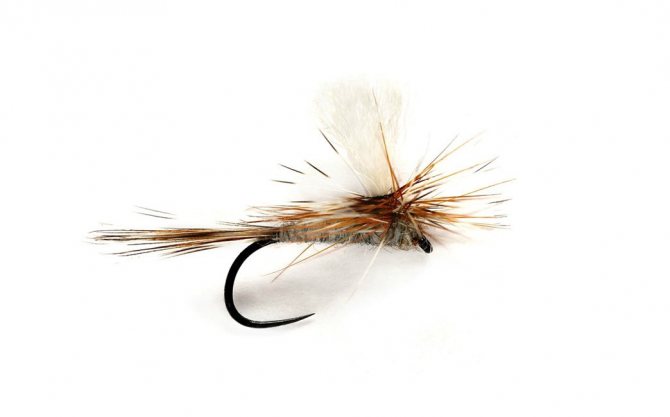
One of the most effective flies. The first ones began to produce it in America. There is no connection to any particular insect, this is just a fantastic fly. But her game and appearance do not leave the fish indifferent. Parachute Adams is made from rooster goatee, but a homemade version can also be made. Detailed instructions can be found on the Internet.
Superpupa
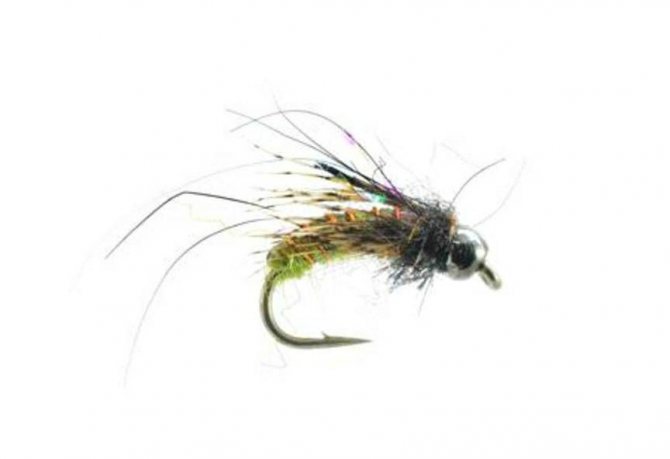
Refers to the dry type of flies. Excellent for catching grayling. Many novice fishermen do not often turn their attention to Superpupa because of its inconspicuous appearance at first glance. But this fly gained its popularity due to the fact that fishing with it is carried out throughout the entire grayling fishing season.
Hydropsyche Nymph
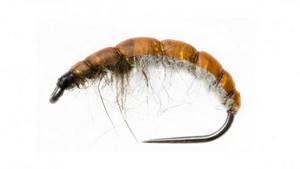
This fly can be classified as the most realistic fly. It is highly effective in catching trophy grayling. Hydropsyche Nymph can be used either with the flow or with the rolling nymph method. It is not easy to knit it at home, but it is quite possible. In the store, such a fly can be found from 70 rubles.
March Brown
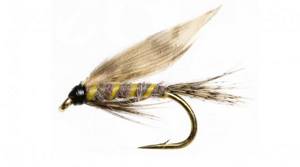
March Brown is a very catchy fly, belonging to the “wet” class. It has become widespread in the UK. Its shape resembles a mayfly. May occur in variations similar to caddisflies. The front sight has been used from 1916 to the present. The only change in this bait was the replacement of silk with Lurex. More catchable in the spring.
Loop Wing Emerger
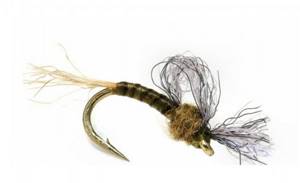
The Loop Wing Emerger fly simulates small and large midge or mayfly larvae. It is used most often on the surface, but with special skills you can also fish in the water column.
Jassid
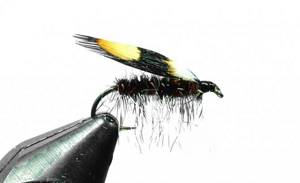
A small-sized fly, used to simulate various beetles, flies and small midges. She was first mentioned in his book by Vincent Mariner. About this fly you can confidently say “If you don’t get a bite, use Jassid!”
Red Ant
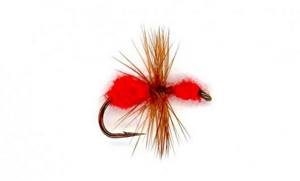
The Red Ant is a very effective fly in the summer. When fishing with this bait, you should always reel in the line, since grayling can accompany the “prey” almost all the way to the angler.
{banner_vnutri-kontenta-3}
Deer Hair Caddis
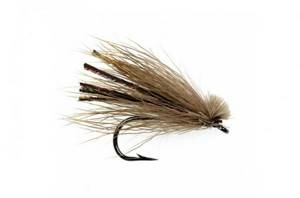
Classic dry fly. Shows itself perfectly in all seasons. Models an adult caddisfly and is very active in the water. Made from thin and oval lurex. Hook sizes 16-17-18 work well for Deer Hair Caddis. Quite difficult to make at home.
Mini Leech
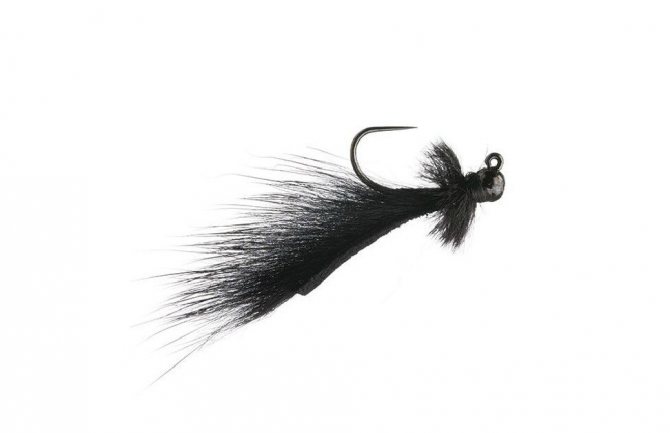
Mini Leech fly imitating leeches, small fish, shrimp. It is worth noting that when creating such a fly, you should not leave a short tail. With a more elongated body, the performance of the bait will be simply amazing, which will definitely attract grayling.
Buck Caddis
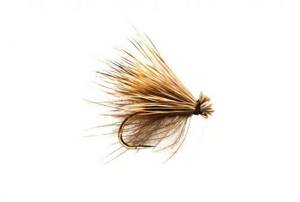
The last catchy fly in this article. This bait performs well in trout fishing, but grayling will not stand aside either. Another advantage worth noting is the rigid structure of the fly, so it does not deform after bites. Buck Caddis imitates an adult caddis fly, so consider this when choosing a hook for this fly. To create such bait, it is recommended to use thick fur, as it is quite dense and easily frays.
DIY flies for grayling
As you know, heavy flies, dry flies and nymphs are suitable for catching this fish. Let's look step by step at how to make each of these types of flies for grayling with your own hands.
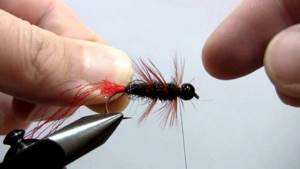
Nymph:
- We take hook number 5. We fix it either in a vice or with pliers.
- We wind the thread that we chose to make the fly onto the hook.
- We use dabbing to make the body and head of our insect.
- Don't forget to leave some material for the tail of the bait.
- We simply cut off the remaining thread.
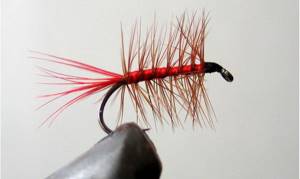
Dry fly:
- Hairs of dark and orange colors are suitable for installation.
- The hook should be taken with the most curved tip, approximately size 5 to 7.
- We thread the wool into the eye of the hook and form a kind of cocoon on it.
- Using a regular needle, we fluff up the hairs, thereby obtaining a resemblance to an insect.
